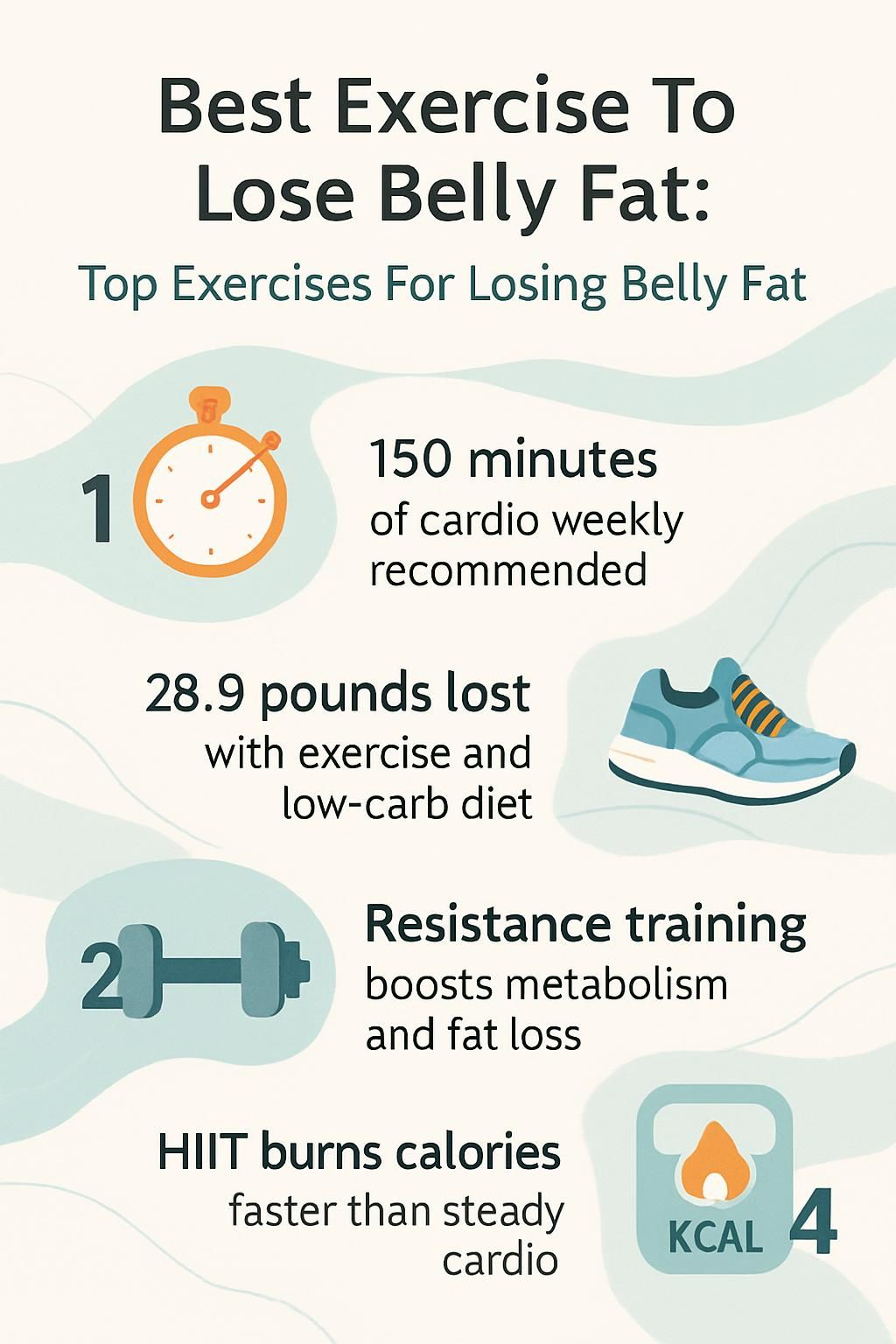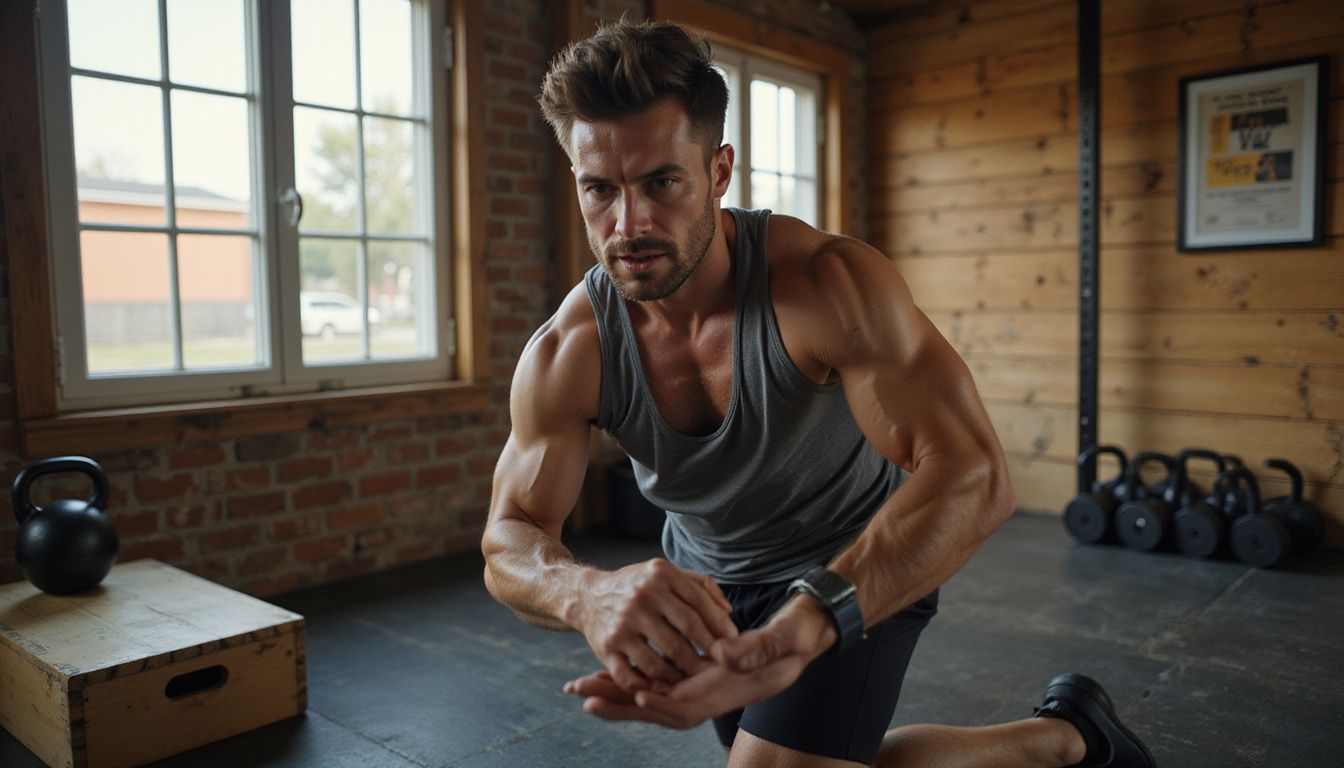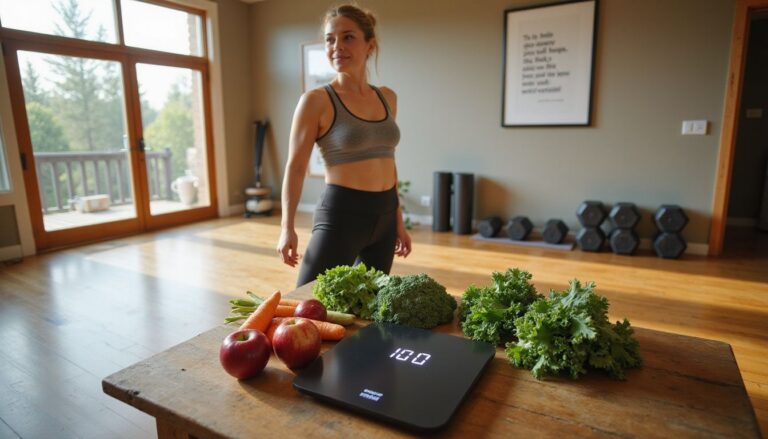Best Exercise To Lose Belly Fat: Top Exercises For Losing Belly Fat
Our Nutrition Assistant AI Suite will transform your body. You will lose fat, get toned, and build muscle. Gain confidence and optimal health.
If losing stubborn belly fat feels slow, you are not alone. Extra weight around your waist raises the risk of heart disease and type 2 diabetes. In this guide, you will learn the best exercise to lose belly fat with clear steps, simple science, and practical tips you can use.
Start today with small changes. The right mix of movement and meals will help you reduce fat around your belly and feel stronger.
Key Takeaways
- Cardio exercises like brisk walking, running, cycling, and swimming for at least 150 minutes per week help reduce belly fat and improve heart health.
- Johns Hopkins research found that pairing regular exercise with a low-carb diet led to an average weight loss of 28.9 pounds in six months.
- Resistance training builds lean muscle mass, which raises metabolism so you burn more calories, even at rest, and supports better fat loss than dieting alone.
- HIIT workouts using sprints, jump squats, burpees, and mountain climbers burn calories faster than steady cardio by raising your metabolic rate during and after exercise.
- You cannot spot-reduce belly fat. Losing it requires consistent aerobic activity plus strength training and healthy nutrition for steady results and lower disease risk.

Can You Lose Belly Fat by Targeting It Directly?

Spot reduction, which means trying to burn fat from one area with one move, does not work. Your body uses stored triglycerides from many places for energy. Doing more sit-ups or extra miles alone will not melt only belly fat.
You lower weight and visceral fat through a calorie deficit. That means you burn more calories than you take in through diet and exercise across your whole body. Johns Hopkins research shows that losing weight in general improves artery function, not just a single body part.
High levels of visceral fat, the deep fat around organs, raise the risk of high blood pressure, heart disease, and metabolic syndrome, even at a normal BMI. I once tried endless crunches to flatten my stomach. Full-body training plus lifestyle changes finally moved the needle.
You cannot choose where your body burns excess fat first.
Regular aerobic exercise and strength training work together to reduce visceral belly fat and improve health markers.
Next, see which effective exercises burn the most calories and create real body composition change.
Effective Exercise Types for Losing Belly Fat
Choosing the right mix of exercise helps you burn more calories and reduce excess visceral fat. Aim for routines that raise your heart rate and build muscle so you can keep burning after each session.
What Are the Best Cardio Workouts for Belly Fat?
Brisk walking, running, swimming, cycling, and rowing are proven exercises to lose fat around your midsection. Aim for at least 30 minutes per day. This helps reduce subcutaneous fat, which sits under the skin, and visceral fat, which surrounds organs.
Daily activity adds up. Dancing, yard work, and playing with kids raise your heart rate and support fat loss. Aerobic exercise boosts metabolism and improves insulin control.
Studies from Johns Hopkins found that combining a low-carb diet with regular exercise led to an average loss of 28.9 pounds in six months.
Pick activities you enjoy so you stick with them. I started biking outdoors most mornings for 45 minutes and adjusted my meals. In three months I dropped over 12 pounds, including inches from my waist.
Steady cardio helps you lower body mass and insulin levels. That means less new belly fat stored and better protection against heart disease and high blood pressure as you get older.
How Does Resistance Training Help Reduce Belly Fat?
Resistance training builds lean muscle. Muscle uses more energy at rest than fat, which raises your metabolism all day, even while you sit or sleep.
Strength train at least twice per week with moves like squats, lunges, rows, presses, and deadlifts. Use lighter weights for 10 to 12 reps or heavier weights for fewer reps. Both methods support muscle gain and fat loss around your midsection.
Research shows strength training helps you keep lean tissue while losing weight compared with dieting alone. Strength training is key if you want to burn belly fat and build a stronger core.
Why Is HIIT Great for Faster Fat Loss?
High-intensity interval training, or HIIT, uses short bursts of near-all-out effort, then rest. Examples include jumping jacks, burpees, pushups, jump squats, and high knees performed for about 30 seconds each.
This style burns calories fast and keeps your metabolism elevated after you finish. Studies show HIIT can reduce belly fat and improve fitness more than moderate cardio alone.
New to HIIT? Start with 15 to 20 reps per move and rest between sets. With practice, these exercises will help increase calorie burn and speed up stomach fat loss.
Next up are the best cardio options to reduce belly fat and flatten your waist.
Best Cardio Exercises to Reduce Belly Fat
Cardio raises your heart rate and helps you burn more calories per minute. Think of it as your daily spark for fat loss.
How Can Brisk Walking Help You Lose Belly Fat?
Brisk walking for at least 30 minutes each day helps you burn calories and reduce belly fat. It is moderate-intensity aerobic exercise, so it suits beginners and people returning to fitness.
The NHS advises at least 150 minutes of moderate activity weekly. Add walking by parking farther away, taking the stairs, or planning a lunch walk.
Walking engages large muscle groups and raises your heart rate. Research shows consistent aerobic exercise reduces visceral adipose tissue in the abdomen, lowering risks linked to diabetes and heart disease.
Bring a friend to make walks social and easier to keep. Many people stay more consistent with a walking buddy and see steady progress.
Can Running Flatten Your Stomach?
Running helps you lose belly fat by burning many calories and boosting your metabolism. Running for 30 to 60 minutes on most days lowers overall body fat, including fat around the abdomen.
Each stride requires core stability, which increases energy use. Outdoor routes or treadmill runs both work. Interval runs, where you mix sprints and recovery, may help you lose weight faster than steady runs.
Experts value aerobic exercise like running because it improves artery function and supports healthy levels of stored fat around organs such as the liver.
Does Swimming Help Burn Belly Fat?
Swimming works your whole body and burns a high number of calories per session. It raises your heart rate, supports heart health, and can reduce belly fat over time.
Reaching 150 minutes per week meets the guideline for moderate activity and supports weight loss. Swimming uses many major muscle groups, which boosts metabolism during and after workouts.
If you have joint pain, swimming is low impact. I added two lap sessions per week last summer. Over several months my core felt stronger and my waist looked slimmer.
Swimming also adds variety so you stay motivated while dropping stubborn belly fat.
How Effective Is Cycling for Belly Fat Loss?
Cycling helps you burn calories and manage belly fat. Ride outdoors or use a stationary bike. Hitting 150 minutes per week, as the NHS suggests, reduces stored fat and supports your circulatory system.
Vary speed or resistance to match your level. Many people add cycling to commutes to build a consistent habit. I began biking to work and noticed a smaller waist and better endurance.
Studies show regular cycling lowers BMI and reduces abdominal fat, especially with smarter eating and calorie control. Even postmenopausal women benefit from steady cycling for body composition and lower cortisol, the main stress hormone.
Resistance Exercises to Reduce Belly Fat
Resistance work builds skeletal muscle and boosts resting metabolism. These exercises also strengthen your core so you move better and safer.
How Do Squats Strengthen Your Core and Legs?
Squats train many muscles at once. Your glutes, quadriceps, hamstrings, and calves work as you sit back and stand tall with feet shoulder-width apart and knees bent.
Keeping your chest up engages your front ab muscles to stabilize your torso. Bodyweight squats and loaded squats both count. I found that sets of 12 reps with light weights made my legs feel stronger in a few weeks.
More lean muscle raises resting calorie burn, which may reduce belly fat over time. Squats also build strength for daily tasks and improve balance through your core and legs.
Can Lunges Improve Core Stability?
Lunges train your core, buttocks, and legs while challenging balance. Each step demands abdominal control to keep posture aligned and hips steady.
Good core strength lowers injury risk during daily activities. Try 12 repetitions per leg. Use bodyweight or hold dumbbells or kettlebells for added resistance.
Better stability helps prevent falls and improves posture. As you progress, strong core muscles support the spine and the organs in your abdomen.
Why Are Deadlifts Good for Full-Body Fat Burn?
Deadlifts work your entire body, including your core, back, and legs. Lifting a barbell from the floor requires many muscles to fire together, which builds strength quickly.
More muscle increases how many calories you burn each day. That helps reduce stubborn belly fat. Deadlifts also raise calorie burn during and after training because so many large muscles are involved.
Use proper form to protect your joints from injury and adjust weight to your level. I added deadlifts twice a week and noticed full-body strength gains and a slimmer waist.
How Do Planks Condition the Core?
Planks are an isometric core exercise, which means you hold a position and create tension. Keep your body in a straight line on your forearms and toes.
You work the abs, lower back, and shoulders at the same time. Holding for about 60 seconds builds stability and improves posture. That support helps protect your spine and organs.
Try easier versions first, then advance to harder ones. Stronger core muscles reduce back pain, improve sport movement, and raise resting calorie burn that supports fat loss.
HIIT Workouts to Boost Belly Fat Loss
Think of HIIT as short sprints for your metabolism. Small bursts can create big change.
How Do Sprint Intervals Accelerate Fat Burn?
Sprint intervals use 30 seconds of near-max effort running followed by the same rest. Repeat several cycles. This pushes your heart rate up fast and raises calorie burn for hours after, a process called EPOC, or excess post-exercise oxygen consumption.
Research shows sprinting helps burn more fat than steady cardio. It taps stored fat for fuel and keeps your metabolism elevated.
Start with fewer rounds and focus on form. Build gradually to lower injury risk while improving fitness and weight loss.
Next, see how jump squats turn up the burn even more.
Are Jump Squats Effective for Fat Loss?
Jump squats are a plyometric move that drives your heart rate up quickly. They also build lower-body power by using your legs and core explosively.
Do 15 to 20 reps per set, then adjust to your fitness level. This exercise gives a strong metabolic boost so your body uses more energy after the workout.
Keep knees tracking over toes and land softly with both feet flat. Good form protects your joints and targets the right muscles. Adding jump squats to my HIIT sessions helped me drop stubborn belly fat faster than steady cardio alone.
What Are the Benefits of Burpees for Belly Fat?
Burpees combine a squat, pushup, and jump in one move. That means many muscles work at once, and your heart rate rises in seconds.
HIIT routines with burpees increase energy use and speed up abdominal fat loss. Interval sets keep metabolism high after you finish. You also build strength, endurance, and heart fitness in a short window.
Beginners can lower the impact by stepping back instead of jumping. You still challenge your core and move toward less belly fat even with modified reps.
Let’s explore how mountain climbers add variety and keep the pace high.
How Do Mountain Climbers Help Burn Belly Fat?
Mountain climbers require no equipment and use only bodyweight. Start in a plank, then drive one knee toward your chest and switch legs quickly.
Aim for 15 to 20 reps per side if you are new. This move works your core, hip flexors, and shoulders while challenging coordination.
HIIT moves like mountain climbers raise your metabolic rate and calorie burn during and after training. My clients often notice better core tone and lower stress with regular practice.
This simple exercise helps reduce belly fat while improving balance and control.
Core Exercises for Stronger Abdominal Muscles
Core training builds strength for better movement in daily life. It also shapes your midsection as you lower total body fat.
How Do Crunches Target Upper Abs?
Crunches target the upper abs by lifting your shoulder blades off the floor while your lower back stays pressed down. Bend your knees with feet flat and focus on slow, controlled lifts.
Perform 12 to 20 repetitions per set and adjust based on comfort. Reverse crunches and bicycle crunches hit other areas, but standard crunches isolate the upper region well.
Stop if you feel neck or back pain and get advice if it persists. Pair crunches with full-body training and smart meals since spot reduction does not remove fat by itself.
Why Are Bicycle Crunches Good for Obliques?
Bicycle crunches train the obliques, the side ab muscles that shape your waist. Keep both feet off the floor and rotate so each elbow meets the opposite knee.
Form matters. Twist from your ribs and keep tension in the core. Try 12 to 20 reps per set to challenge the sides without strain.
Including bicycle crunches supports a balanced core routine. Strong obliques help with rotation and stability in sports and daily tasks.
How Do Russian Twists Improve Core Rotation?
Russian twists teach your core to control rotation. Sit with your feet raised or anchored, hold a weight or ball, and twist your torso side to side.
This action activates the obliques and deeper core muscles. Regular practice improves coordination and movement patterns, which can reduce injury risk and improve performance.
Protect your lower back by keeping your chest up and rotating from the ribcage, not just the arms. Over time, greater core endurance supports fat loss work around your waist.
What Are the Benefits of Leg Raises for Lower Abs?
Lying leg raises target the lower abs. Keep your back flat, lift your feet together, and pause at the top for one or two seconds.
Do 10 to 15 reps per set. This exercise builds core strength, supports posture, and improves definition as body fat drops.
If you have a history of back issues, check with a clinician first. Keep control on each rep and avoid arching your back to prevent strain.
Tips to Improve Fat Loss During Exercise
Small changes turn good workouts into great ones. Use these strategies to get more from each session.
Why Combine Cardio and Strength Training?
Cardio burns calories quickly. Strength training builds muscle that burns more calories all day. Together, they help you lose belly fat and keep lean mass.
Aim for at least two days of strength work plus 150 minutes of moderate cardio per week. Johns Hopkins findings show better fat loss with a low-carb diet paired with regular exercise.
Switching between runs and deadlifts kept my progress steady and my workouts engaging. This approach supports your metabolism, lowers stress responses, and protects muscle as the scale goes down.
How Important Is Consistency and Progress?
Consistency beats random hard efforts. Small daily actions like a brisk walk or a short lift session build momentum and keep your plan realistic.
Track progress using how clothes fit or how you feel during workouts, not only the scale. Increase time, reps, or intensity slowly. For example, add one burpee per week instead of jumping into heavy Olympic lifts too soon.
Support from friends or a group can help you stick with your goals for the long haul.
How Can You Ensure Proper Exercise Form?
Good form prevents injury and improves results. Warm up with light movement before training, then cool down afterward to help recovery.
Start slow with new moves like deadlifts or planks and focus on technique, not speed or weight. Studies show beginners who learn correct form lower strain risk by about one third.
Ask a trainer or experienced friend to check your form. If pain appears in any joint or muscle, stop and seek advice if it continues. Proper technique makes fat loss safer and more efficient.
What Nutritional Choices Support Fat Loss?
Choose an eating plan you can maintain. Build meals with high-fiber vegetables, beans, and lean protein to control hunger and support muscle repair.
Foods like broccoli, spinach, chicken breast, fish, and black beans offer strong nutrition with fewer calories. Lower-carb approaches often help reduce belly fat by keeping insulin steady.
Limit processed foods high in trans fat, added sugar, and sodium. Read labels closely, since some low-fat items are loaded with extra carbs. Sauces and dressings can add hidden calories. Intermittent fasting may help if used safely with balanced meals.
How to Exercise Safely When Losing Belly Fat
Smart safety habits protect your progress. A little planning keeps your joints and muscles healthy while you lose weight.
Why Is Warming Up Important?
Warming up prepares your body for harder work and lowers injury risk. The NHS recommends starting every workout with a warm-up to raise heart rate, improve blood flow, and increase flexibility.
Research shows warm-ups before cardio and lifting help prevent strains by letting muscles adjust to stress. I spend 5 to 10 minutes on brisk walking and dynamic stretches. That simple step reduces soreness later.
Skipping a warm-up increases the chance of joint or muscle issues that can slow your progress with belly fat loss.
How to Avoid Overtraining with Balanced Workouts?
Plan one or two rest days per week for recovery. Too much training can raise cortisol, which may slow belly fat loss and make recovery harder.
Get at least 30 minutes of moderate exercise daily, but avoid going hard every day. Mix cardio, lifting, and HIIT to spread the load across different muscles.
Watch for warning signs like heavy fatigue or dropping performance. I saw better results after I scheduled full rest days and used light recovery walks between tougher sessions.
What Body Signals Should You Watch For?
Stop exercise if you feel pain, dizziness, or shortness of breath. These may signal overexertion or injury risk. Lower intensity or modify the workout if discomfort appears.
Persistent pain needs medical advice. Early attention protects your progress and keeps training safe.
When Should You Seek Professional Advice?
If you live with conditions like heart disease or diabetes, talk with your doctor before starting a new program for stubborn belly fat. Safety comes first.
Seek expert help for joint or back pain before continuing with squats, lunges, or other strength moves. Pain that lasts more than a few days needs an evaluation.
Cardiac rehabilitation professionals, such as Laura Cartwright at the Ciccarone Center for Prevention of Heart Disease, guide people with higher medical risk. Exercise physiologists can tailor plans and track your progress. I once had sharp lower-back pain after pushing too fast. An expert helped me adjust and continue safely.
Use clinical weight and nutrition services if you need more support. Professionals can make sure each step is safe and effective.
Conclusion
Losing belly fat takes patience and steady effort. You cannot target only your waist, but you can lower it through consistent exercise and smarter meals. Cardio, HIIT, and resistance training work together to burn calories and build muscle.
Each workout type supports your metabolism during and after training. Mix aerobic exercise with strength moves for better results. Choose activities you enjoy so the habit sticks.
A low-carb approach may speed progress according to Johns Hopkins research. Stay safe, listen to your body, and speak with a health professional if you have medical concerns. With daily commitment, stubborn belly fat gives way and your health improves.
…
1: [Johns Hopkins Medicine – Low-Carb vs Low-Fat Diet Study](https://www.hopkinsmedicine.org/news/media/releases/lowcarb_diet_burns_the_most_calories_in_latest_weightloss_study)
FAQs
1. Why is belly fat so stubborn compared to other body fat?
Belly fat can be stubborn because it often stores more visceral fat, which sits deeper in the abdomen. This type of fat responds slower to diet and exercise changes than subcutaneous fat found elsewhere on the body.
2. What are the best exercises for losing belly fat?
Aerobic activities such as brisk walking, running, or cycling help burn calories and reduce overall weight. Strength training also supports muscle growth, which increases metabolism and helps target stubborn belly areas.
3. Can I lose only my belly fat with targeted exercises?
Spot reduction is not supported by scientific evidence; you cannot lose just your belly fat through specific movements alone. A combination of full-body workouts and a balanced diet leads to better results for reducing weight and improving your overall health.
4. How does losing weight improve your overall well-being beyond appearance?
Reducing excess abdominal weight lowers risks linked to heart disease, diabetes, and high blood pressure according to several studies (Harvard Health Publishing). Improved fitness from regular exercise also boosts energy levels and mental clarity while supporting long-term wellness goals.
Summary: Belly area adiposity can be persistent due to its unique composition but responds well when aerobic activity combines with strength training routines. Evidence shows that focusing on total body health rather than isolated spots produces lasting improvements in both physical condition and general well-being.







